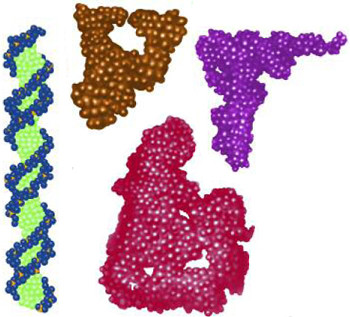


2018-06-13
RNA stands for ribonucleic acid. It is an important molecule with long chains of nucleotides. A nucleotide contains a nitrogenous base, a ribose sugar, and a phosphate. Just like DNA, RNA is vital for living beings.

RNA comes in a variety of different shapes. Double-stranded DNA is a staircase-like molecule. Image Credit: National Institute of General Medical Sciences
Ribonucleic acid (RNA) has the bases adenine (A), cytosine (C), guanine (G), and uracil (U). Image Credit: National Institute of General Medical Sciences
DNA compared to RNA
DNA is defined as a nucleic acid that contains the genetic instructions used in the development and functioning of all known living organisms. RNA molecules are involved in protein synthesis and sometimes in the transmission of genetic information.
However unlike DNA, RNA comes in a variety of shapes and types. While DNA looks like a double helix and a twisted ladder, RNA may be of more than one type. RNA is usually single-stranded, while DNA is usually double-stranded. In addition, RNA contains ribose while DNA contains deoxyribose. Deoxyribose lacks one oxygen atom. RNA has the bases Adenine (A), Uracil (U) (instead of thymine in DNA), Cytosine (C) and Guanine (G).

Deoxyribose sugar in DNA is less reactive because of C-H bonds. DNA is stable in alkaline conditions. DNA has smaller grooves where the damaging enzyme can attach which makes it harder for the enzyme to attack DNA.
Ribose sugar however is more reactive because of C-OH (hydroxyl) bonds. RNA is not stable in alkaline conditions. RNA has larger grooves, which makes it easier to be attacked by enzymes.
The helix geometry of DNA is of B Form. DNA can be damaged by exposure to Ultraviolet rays. The helix geometry of RNA is of A-Form. RNA strands are continually made, broken down and reused. RNA, however, is more resistant to damage by Ultra-violet rays.
Functions of RNA
The main job of RNA is to transfer the genetic code need for the creation of proteins from the nucleus to the ribosome. This process prevents the DNA from having to leave the nucleus. This keeps the DNA and genetic code protected from damage. Without RNA, proteins could never be made.
mRNA, rRNA and tRNA
RNA is formed from DNA by a process called transcription. This uses enzymes like RNA polymerases. RNA is central to protein synthesis. First a type of RNA called messenger RNA (mRNA) carries information from DNA to structures called ribosomes. These ribosomes are made from proteins and ribosomal RNAs (rRNAs). These all come together and form a complex that can read messenger RNAs and translate the information they carry into proteins. This requires the help of transfer RNA or tRNA.
RNAs as enzymes
Some RNAs are enzymes. It was widely believed for many years that only proteins could be enzymes. RNAs are now known to adopt complex tertiary structures and act as biological catalysts. Such RNA enzymes are known as ribozymes, and they exhibit many of the features of a classical enzyme, such as an active site, a binding site for a substrate and a binding site for a cofactor, such as a metal ion.
One of the first ribozymes to be discovered was RNase P, a ribonuclease that is involved in generating tRNA molecules from larger, precursor RNAs. RNase P is composed of both RNA and protein; however, the RNA moiety alone is the catalyst.
Your name*
Your E-mail*
Got a question?*